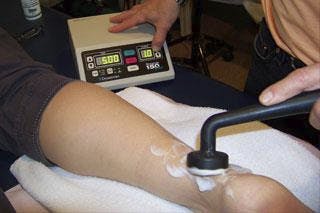By: Teresa Grant, PT
We tend to associate warmth with relaxation and a feeling of tranquility. But, heat can have physiological effects as well. Heat can be both superficial such as a heating pad or it can be deep. Ultrasound delivers a deep heat.
Ultrasound's physiological effects can be to decrease pain, stimulate an increase in blood flow, increase soft tissue extensibility and decrease muscle spasm. Ultrasound can prepare stiff joints and soft tissue for exercise and stretching.

As sound waves pass through the different tissues they absorb kinetic energy thus creating heat. Absorption varies with the different tissues as the waves pass through skin, fat, muscle and down to the bone.
By changing the duty cycle and intensity, ultrasound can have either a thermal or a non-thermal effect. Examples of non-thermal effects are soft tissue repair, tendon repair, and stimulating increased blood flow.
In the clinic setting, ultrasound is frequently used for tendonitis, carpal tunnel, muscle spasm, over trigger points and over joint capsules prior to stretching, to name a few examples.
With ultrasound, because of its deep effect, the heat is barely perceived. This leads some patients to question whether anything is happening. As patients experience a decrease in their symptoms, many become believers in the therapeutic benefits of ultrasound.
If you have any questions or would like to learn how to add ultrasound to your program Purcellville Orthopedic Physical Therapy will be happy to help in anyway.

